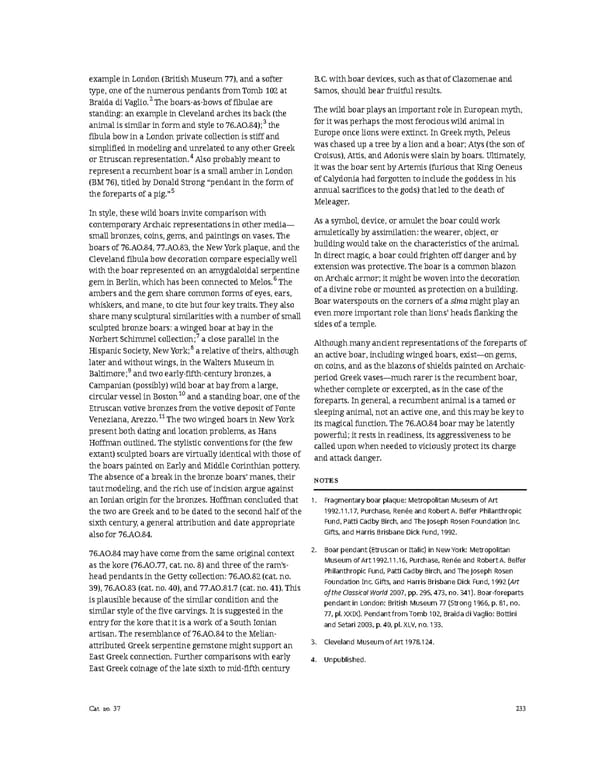example in London (British Museum 77), and a softer B.C. with boar devices, such as that of Clazomenae and type, one of the numerous pendants from Tomb 102 at Samos, should bear fruitful results. Braida di Vaglio.2 The boars-as-bows of fibulae are standing: an example in Cleveland arches its back (the The wild boar plays an important role in European myth, animal is similar in form and style to 76.AO.84);3 the for it was perhaps the most ferocious wild animal in fibula bow in a London private collection is stiff and Europe once lions were extinct. In Greek myth, Peleus simplified in modeling and unrelated to any other Greek was chased up a tree by a lion and a boar; Atys (the son of or Etruscan representation.4 Also probably meant to Croisus), Attis, and Adonis were slain by boars. Ultimately, represent a recumbent boar is a small amber in London it was the boar sent by Artemis (furious that King Oeneus (BM 76), titled by Donald Strong “pendant in the form of of Calydonia had forgotten to include the goddess in his the foreparts of a pig.”5 annual sacrifices to the gods) that led to the death of Meleager. In style, these wild boars invite comparison with contemporary Archaic representations in other media— As a symbol, device, or amulet the boar could work small bronzes, coins, gems, and paintings on vases. The amuletically by assimilation: the wearer, object, or boars of 76.AO.84, 77.AO.83, the New York plaque, and the building would take on the characteristics of the animal. Cleveland fibula bow decoration compare especially well In direct magic, a boar could frighten off danger and by with the boar represented on an amygdaloidal serpentine extension was protective. The boar is a common blazon gem in Berlin, which has been connected to Melos.6 The on Archaic armor; it might be woven into the decoration ambers and the gem share common forms of eyes, ears, of a divine robe or mounted as protection on a building. whiskers, and mane, to cite but four key traits. They also Boar waterspouts on the corners of a sima might play an share many sculptural similarities with a number of small even more important role than lions’ heads flanking the sculpted bronze boars: a winged boar at bay in the sides of a temple. Norbert Schimmel collection;7 a close parallel in the 8 Although many ancient representations of the foreparts of Hispanic Society, New York; a relative of theirs, although an active boar, including winged boars, exist—on gems, later and without wings, in the Walters Museum in on coins, and as the blazons of shields painted on Archaic- Baltimore;9 and two early-fifth-century bronzes, a period Greek vases—much rarer is the recumbent boar, Campanian (possibly) wild boar at bay from a large, whether complete or excerpted, as in the case of the circular vessel in Boston10 and a standing boar, one of the foreparts. In general, a recumbent animal is a tamed or Etruscan votive bronzes from the votive deposit of Fonte sleeping animal, not an active one, and this may be key to Veneziana, Arezzo.11 The two winged boars in New York its magical function. The 76.AO.84 boar may be latently present both dating and location problems, as Hans powerful; it rests in readiness, its aggressiveness to be Hoffman outlined. The stylistic conventions for (the few called upon when needed to viciously protect its charge extant) sculpted boars are virtually identical with those of and attack danger. the boars painted on Early and Middle Corinthian pottery. The absence of a break in the bronze boars’ manes, their NOTES taut modeling, and the rich use of incision argue against an Ionian origin for the bronzes. Hoffman concluded that 1. Fragmentary boar plaque: Metropolitan Museum of Art the two are Greek and to be dated to the second half of the 1992.11.17, Purchase, Renée and Robert A. Belfer Philanthropic sixth century, a general attribution and date appropriate Fund, Patti Cadby Birch, and The Joseph Rosen Foundation Inc. also for 76.AO.84. Gifts, and Harris Brisbane Dick Fund, 1992. 76.AO.84 may have come from the same original context 2. Boar pendant (Etruscan or Italic) in New York: Metropolitan as the kore (76.AO.77, cat. no. 8) and three of the ram’s- Museum of Art 1992.11.16, Purchase, Renée and Robert A. Belfer head pendants in the Getty collection: 76.AO.82 (cat. no. Philanthropic Fund, Patti Cadby Birch, and The Joseph Rosen 39), 76.AO.83 (cat. no. 40), and 77.AO.81.7 (cat. no. 41). This Foundation Inc. Gifts, and Harris Brisbane Dick Fund, 1992 (Art is plausible because of the similar condition and the of the Classical World 2007, pp. 295, 473, no. 341). Boar-foreparts similar style of the five carvings. It is suggested in the pendant in London: British Museum 77 (Strong 1966, p. 81, no. 77, pl. XXIX). Pendant from Tomb 102, Braida di Vaglio: Bottini entry for the kore that it is a work of a South Ionian and Setari 2003, p. 40, pl. XLV, no. 133. artisan. The resemblance of 76.AO.84 to the Melian- attributed Greek serpentine gemstone might support an 3. Cleveland Museum of Art 1978.124. East Greek connection. Further comparisons with early 4. Unpublished. East Greek coinage of the late sixth to mid-fifth century Cat. no. 37 233
 Ancient Carved Ambers in the J. Paul Getty Museum Page 242 Page 244
Ancient Carved Ambers in the J. Paul Getty Museum Page 242 Page 244